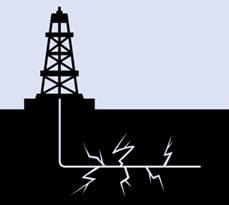Article from The Conversation (theconversation.com) on 21 January 2014. The text reprinted here:
by Chris Hope, Reader in Policy Modelling, Cambridge Judge Business School
 While the prime minister has shown unequivocal support for exploiting Britain’s shale gas reserves, stating the country should “go all out for shale gas”, more cautious voices point to possible effects such as minor earthquakes, contamination of water sources and industrialisation of the countryside.
While the prime minister has shown unequivocal support for exploiting Britain’s shale gas reserves, stating the country should “go all out for shale gas”, more cautious voices point to possible effects such as minor earthquakes, contamination of water sources and industrialisation of the countryside.
Besides these, shale gas will contribute to climate change in two ways, from carbon dioxide (CO2) emissions when the gas is burnt, and from the fugitive emissions of underground methane (CH4) that leak into the atmosphere as the gas is extracted. These concerns have led to protests against the drilling of shale gas exploratory wells. Others are more willing to accept shale gas, but as a fuel used only for a few years as the country gears up for a low carbon future.
Putting a price on it
How are we to make sense of this? One approach is to avoid the all-or-nothing rhetoric and instead insist that the companies producing shale gas, like every other polluter, should pay for the environmental damage shale gas will bring upon future generations through its contribution to climate change.
How much should they pay? For every tonne of CO2 emitted when the shale gas is burned, the company producing it should pay the amount by which it increases the impacts of climate change. This is known as the social cost of carbon. In a similar fashion, for every tonne of methane that escapes into the atmosphere it should pay for the social cost of methane.
The social cost of carbon has been well studied over the years. The model we use to calculate it, the PAGE09 integrated assessment model, employs simple equations to simulate the results from more complex, specialised, scientific and economic models. It does this while accounting for the profound uncertainty that exists around climate change. Calculations are made for eight world regions, ten time periods to the year 2200, for four types of impact (sea level rise, economic impacts, non‐economic impacts, and discontinuities, such as the melting of the Greenland and West Antarctic ice sheets). On our present emissions path, the best estimate is that the social cost is a little more than US$100 per tonne of CO2.
The social cost of methane has been much less studied. We know from estimates of Global Warming Potentials – the warming effects of each greenhouse gas – that methane, tonne for tonne, is much more potent than CO2. Initial results from the PAGE09 model indicate that at our present rate of emissions, the best estimate is that the social cost of methane is a little over US$1,500 per tonne. This is why the prospect of considerable methane emissions from fracking has caused such concern.
The polluter pays
How would this approach work in practice? Every company involved in shale gas exploration and production would know from the start that they would have to pay a tax equivalent to the social cost on each tonne of CO2 emitted, and another equivalent to the cost of each tonne of methane escaping from their wells. Many prospects that initially look promising will turn out not to be worth pursuing once these taxes are factored into the calculation. The better, cheaper, prospects where fugitive emissions can be minimised will be favoured.

Should shale gas be a transitional fuel? Tax will determine this. If we carry on along our present path, the social cost of carbon increases in real terms by a little more than two percent per year, doubling in about 30 years. For methane, the cost rises a little faster, doubling in about 20 years. So fewer and fewer shale gas prospects will look attractive as time goes by.
On the other hand, if the world is very successful at bringing global greenhouse gas emissions under control, the social costs will not increase over time, and shale gas will be able to play more of a role for longer. If climate change “lukewarmists” are right and the effects of greenhouse gases on the climate has been overstated, then these social costs will end up lower, around US$65 and US$1,000 per tonne respectively, which would allow more shale gas development.
Applying climate change-based taxes like these to shale gas should be attractive to the government. It is a market-based approach which encourages cleaner development and innovation to reduce environmental impact. It offers the prospect of significant tax revenues, which start at US$100 per tonne of CO2 and US$1,500 per tonne of methane, but which will rise in real terms – all at a time of austerity when the budget deficit is still a concern.
Under the Institute of Directors’ central production estimate, and with a central methane leakage rate of two percent, the tax revenues will be about £6bn per year (in current prices) by the time shale gas production really gets going in the latter half of the 2020s. This is all based on the polluter-pays principle that should be at the heart of this self-described “greenest government ever”.
The government’s “sweeteners”, of one percent of shale gas revenues to local communities and handing local authorities all of the business rates arising from shale gas wells, can be seen as a financial compensation for the disruption fracking will cause locally. The introduction of climate change taxation would tackle the far greater global disruption that the climate effects of shale gas would otherwise bring.

